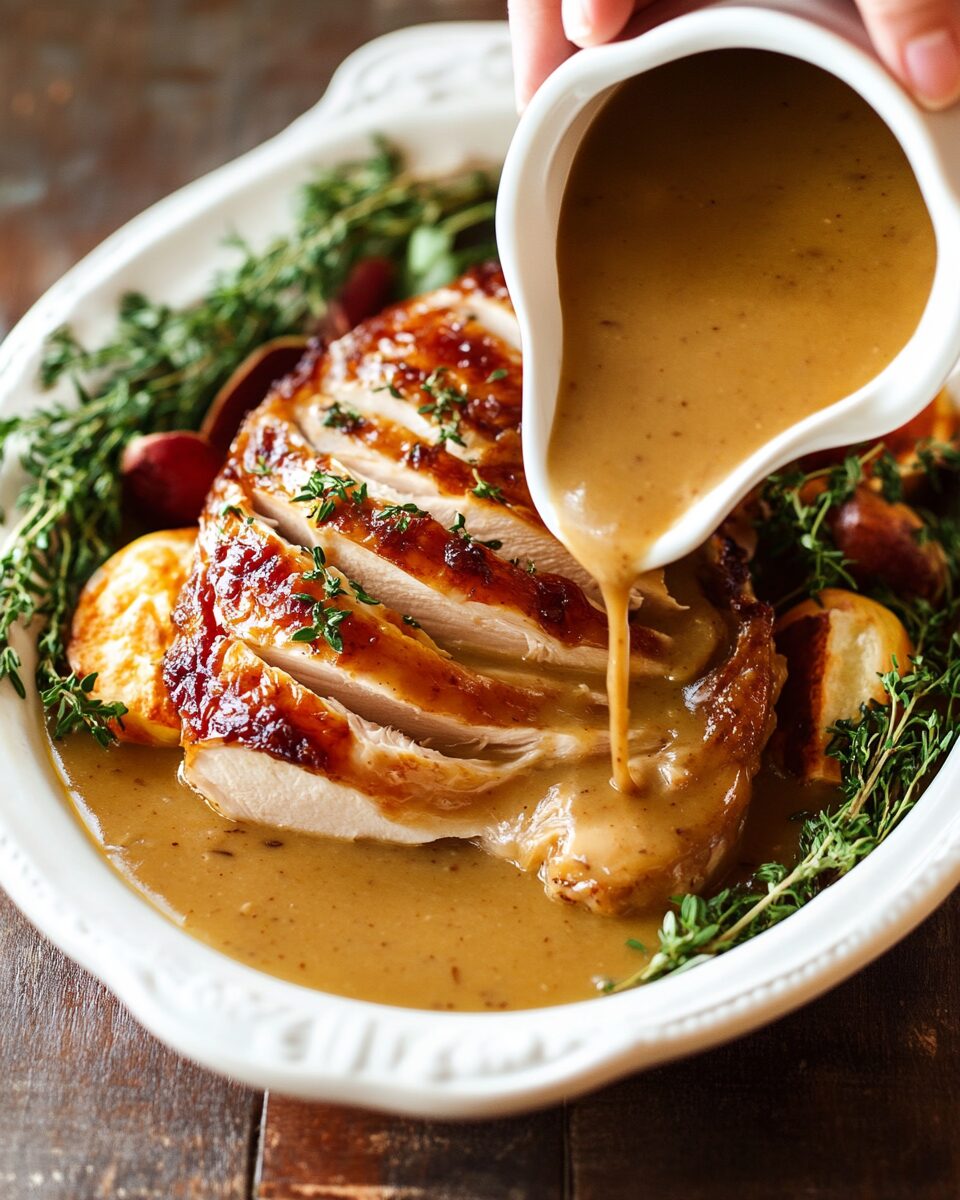This rich and velvety turkey gravy is the ultimate companion to your Thanksgiving turkey. Made with flavorful pan drippings, fresh herbs, and a golden roux, it delivers a depth of flavor that elevates any holiday spread.
Quick to prepare and deeply satisfying, this gravy ensures a foolproof addition to your feast. Whether poured over succulent turkey, fluffy mashed potatoes, or buttery stuffing, it ties all the dishes on your table together with a savory, herbaceous note. Perfect for impressing guests or simply indulging with family, it’s a holiday must-have.
Full Recipe:
- 2 1/2 cups pan drippings (strained and solids discarded)
- 1/4 cup unsalted butter
- 1/4 cup all-purpose flour (or gluten-free flour for substitution)
- 2 teaspoons fresh thyme, chopped
- 1 tablespoon fresh parsley, chopped
- Kosher salt and freshly ground black pepper, to taste
Directions:
- Strain pan drippings through a fine-mesh sieve to remove solids, then measure 2 1/2 cups; set aside.
- In a medium saucepan over medium heat, melt butter until fully liquified.
- Whisk in flour and fresh thyme, cooking until lightly golden and aromatic, about 1 minute.
- Slowly whisk in reserved pan drippings, ensuring a smooth consistency.
- Bring the mixture to a gentle boil, then reduce heat to low. Simmer, whisking frequently, until the gravy thickens, about 5-10 minutes.
- Stir in parsley, then season with salt and freshly ground black pepper to taste.
- Serve warm and enjoy your perfectly crafted gravy!
Prep Time: 5 minutes | Cooking Time: 15 minutes | Total Time: 20 minutes
Kcal: 120 kcal per serving | Servings: 8 servings
The Art of Making the Perfect Turkey Gravy
Turkey gravy is more than just a sauce—it’s the soul of a Thanksgiving feast. Its velvety texture and rich, savory flavor tie together all the classic dishes on your holiday table. From succulent turkey to creamy mashed potatoes and buttery stuffing, a good gravy brings harmony to every bite. Whether you’re hosting your first Thanksgiving or you’re a seasoned holiday chef, understanding the nuances of crafting turkey gravy can elevate your meal to gourmet status.
Why Turkey Gravy is Essential for Thanksgiving
The role of turkey gravy goes far beyond mere tradition. It’s the unifying thread that connects the diverse elements of a Thanksgiving spread. While the turkey may be the centerpiece and sides like cranberry sauce or green bean casserole add variety, gravy is the culinary glue that marries all these flavors together. A drizzle of rich, herbaceous gravy can instantly transform a plate of simple ingredients into a harmonious masterpiece.
Moreover, turkey gravy allows you to make full use of your bird, utilizing the flavorful drippings created during the roasting process. These drippings are packed with concentrated turkey essence and aromatic spices, making them a key ingredient for a truly delectable gravy.
The Science of a Great Gravy
At its core, turkey gravy is an emulsion—a mixture of fat, flour, and liquid. Achieving the perfect consistency is a balance of technique and timing. The base of the gravy, often called a roux, is a combination of flour and fat (typically butter or turkey drippings). This mixture is cooked until golden, creating a nutty depth of flavor.
The liquid—either turkey drippings, stock, or a mix of both—is then slowly whisked into the roux. This process thickens the sauce, giving it that signature smooth texture. The addition of fresh herbs like thyme and parsley enhances the natural flavors, making each spoonful a burst of savory delight.
Common Challenges in Gravy-Making
Even experienced cooks can face challenges when making turkey gravy. Here are some common issues and how to overcome them:
- Lumps: Lumpy gravy can occur if the liquid is added too quickly or the roux isn’t properly whisked. The key is to add the liquid gradually while continuously whisking to ensure a smooth consistency.
- Thin Consistency: If the gravy is too thin, it may need more roux or a longer cooking time to reduce and thicken. Alternatively, you can mix a slurry of flour and water to add at the end of the cooking process.
- Lack of Flavor: Bland gravy often results from using low-quality stock or insufficient seasoning. Always taste and adjust the seasoning with salt, pepper, and herbs as needed.
- Too Salty: This can happen if your pan drippings are heavily seasoned. To fix overly salty gravy, add a bit of unsalted stock or water to dilute the saltiness.
Tips for Perfecting Your Gravy
Mastering turkey gravy is easier with a few tried-and-true tips:
- Strain the Pan Drippings: Use a fine-mesh sieve to remove solids from the drippings, leaving you with a smooth, flavorful base. This step is crucial for avoiding a grainy texture.
- Use Quality Stock: If you don’t have enough drippings, supplement with a high-quality chicken or turkey stock. Homemade stock is ideal, but store-bought options can work in a pinch.
- Incorporate Fresh Herbs: Fresh thyme, parsley, and even a touch of sage can add depth and complexity to your gravy. If fresh herbs aren’t available, dried herbs can be substituted in smaller quantities.
- Don’t Skip the Roux: Cooking the roux properly is essential for achieving a velvety texture. Take the time to let it develop a light golden color for maximum flavor.
- Whisk Continuously: Whisking not only prevents lumps but also ensures the gravy has a silky, even consistency.
Serving Suggestions for Turkey Gravy
Turkey gravy is as versatile as it is essential. While it’s traditionally served with turkey, its uses extend far beyond the holiday bird. Here are some creative ways to enjoy your gravy:
- Mashed Potatoes: No Thanksgiving plate is complete without a generous ladle of gravy over creamy mashed potatoes.
- Stuffing: Add a drizzle of gravy to stuffing to enhance its flavor and moisture.
- Biscuits: Leftover gravy makes a fantastic topping for warm, flaky biscuits.
- Vegetables: Roasted vegetables like carrots, Brussels sprouts, and parsnips pair wonderfully with turkey gravy.
- Pot Pies: Use leftover gravy as a base for turkey pot pie filling, combining it with chopped turkey, vegetables, and a flaky crust.
Customizing Your Gravy
One of the best things about turkey gravy is its adaptability. Depending on your taste preferences or dietary needs, you can make adjustments to create a gravy that suits your table:
- For a Richer Gravy: Add a splash of heavy cream or a pat of butter just before serving.
- To Make it Gluten-Free: Substitute all-purpose flour with a gluten-free flour blend or cornstarch.
- Herb Variations: Experiment with rosemary, sage, or oregano for different flavor profiles.
- Vegan Option: Skip the drippings and use vegetable stock with olive oil or vegan butter to create a plant-based version.
Why Homemade Gravy Beats Store-Bought
While it’s tempting to grab a jar or packet of pre-made gravy, there’s no substitute for homemade. Store-bought versions often contain preservatives, artificial flavors, and excessive sodium. Homemade gravy, on the other hand, allows you to control the quality of ingredients and tailor the seasoning to your liking.
Making your own gravy also connects you to the heart of the Thanksgiving tradition. It’s a simple yet rewarding way to showcase your culinary skills and impress your guests.
Storing and Reusing Turkey Gravy
If you find yourself with leftover gravy, don’t let it go to waste! Turkey gravy stores well in the refrigerator for up to three days or in the freezer for up to three months. To freeze, let the gravy cool completely, then pour it into freezer-safe containers or ice cube trays for portioned servings.
Reheating is simple: thaw the gravy in the refrigerator overnight (if frozen) and warm it in a saucepan over low heat. Add a splash of stock or water to adjust the consistency if needed.
A Conclusion Worth Savory
The perfect turkey gravy is more than just a recipe—it’s a skill that ties together the elements of your Thanksgiving feast. By focusing on quality ingredients, mastering a few simple techniques, and adding your own creative touches, you can create a gravy that elevates your holiday meal to unforgettable heights.
Whether you’re serving it over turkey, mashed potatoes, or a variety of sides, a rich and flavorful turkey gravy is the crowning jewel of any Thanksgiving table. It’s a labor of love that adds warmth, tradition, and deliciousness to every bite. So this holiday season, take pride in creating a gravy that not only enhances your feast but becomes a cherished part of your culinary repertoire.

